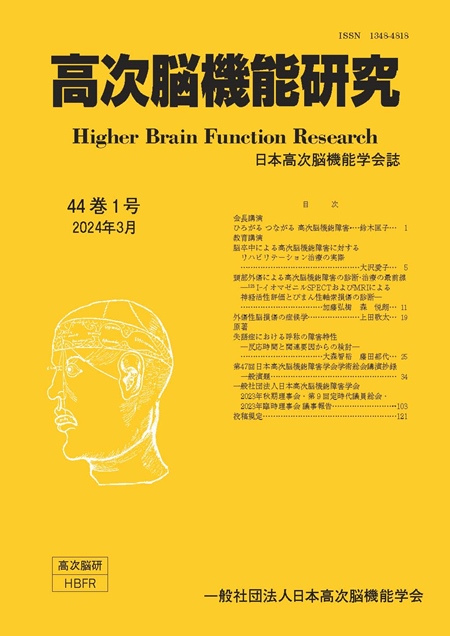Current issue
Displaying 1-43 of 43 articles from this issue
- |<
- <
- 1
- >
- >|
President's lecture
-
2024 Volume 44 Issue 1 Pages 1-4
Published: March 31, 2024
Released on J-STAGE: April 11, 2024
Download PDF (316K)
Educational lectures
-
2024 Volume 44 Issue 1 Pages 5-10
Published: March 31, 2024
Released on J-STAGE: April 11, 2024
Download PDF (534K) -
2024 Volume 44 Issue 1 Pages 11-18
Published: March 31, 2024
Released on J-STAGE: April 11, 2024
Download PDF (830K) -
2024 Volume 44 Issue 1 Pages 19-24
Published: March 31, 2024
Released on J-STAGE: April 11, 2024
Download PDF (487K)
Original article
-
2024 Volume 44 Issue 1 Pages 25-33
Published: March 31, 2024
Released on J-STAGE: April 11, 2024
Download PDF (887K)
-
2024 Volume 44 Issue 1 Pages 34-35
Published: March 31, 2024
Released on J-STAGE: April 11, 2024
Download PDF (1009K) -
2024 Volume 44 Issue 1 Pages 35-37
Published: March 31, 2024
Released on J-STAGE: April 11, 2024
Download PDF (1021K) -
2024 Volume 44 Issue 1 Pages 37-39
Published: March 31, 2024
Released on J-STAGE: April 11, 2024
Download PDF (1020K) -
2024 Volume 44 Issue 1 Pages 39-41
Published: March 31, 2024
Released on J-STAGE: April 11, 2024
Download PDF (1020K) -
2024 Volume 44 Issue 1 Pages 41-43
Published: March 31, 2024
Released on J-STAGE: April 11, 2024
Download PDF (1020K) -
2024 Volume 44 Issue 1 Pages 43-45
Published: March 31, 2024
Released on J-STAGE: April 11, 2024
Download PDF (1021K) -
2024 Volume 44 Issue 1 Pages 45-47
Published: March 31, 2024
Released on J-STAGE: April 11, 2024
Download PDF (1021K) -
2024 Volume 44 Issue 1 Pages 47-49
Published: March 31, 2024
Released on J-STAGE: April 11, 2024
Download PDF (1019K) -
2024 Volume 44 Issue 1 Pages 49-51
Published: March 31, 2024
Released on J-STAGE: April 11, 2024
Download PDF (1018K) -
2024 Volume 44 Issue 1 Pages 51-53
Published: March 31, 2024
Released on J-STAGE: April 11, 2024
Download PDF (1019K) -
2024 Volume 44 Issue 1 Pages 53-55
Published: March 31, 2024
Released on J-STAGE: April 11, 2024
Download PDF (1019K) -
2024 Volume 44 Issue 1 Pages 55-57
Published: March 31, 2024
Released on J-STAGE: April 11, 2024
Download PDF (1020K) -
2024 Volume 44 Issue 1 Pages 57-59
Published: March 31, 2024
Released on J-STAGE: April 11, 2024
Download PDF (1023K) -
2024 Volume 44 Issue 1 Pages 59-61
Published: March 31, 2024
Released on J-STAGE: April 11, 2024
Download PDF (1021K) -
2024 Volume 44 Issue 1 Pages 61-62
Published: March 31, 2024
Released on J-STAGE: April 11, 2024
Download PDF (1013K) -
2024 Volume 44 Issue 1 Pages 62-64
Published: March 31, 2024
Released on J-STAGE: April 11, 2024
Download PDF (1019K) -
2024 Volume 44 Issue 1 Pages 64-65
Published: March 31, 2024
Released on J-STAGE: April 11, 2024
Download PDF (1011K) -
2024 Volume 44 Issue 1 Pages 65-67
Published: March 31, 2024
Released on J-STAGE: April 11, 2024
Download PDF (1020K) -
2024 Volume 44 Issue 1 Pages 67-69
Published: March 31, 2024
Released on J-STAGE: April 11, 2024
Download PDF (1019K) -
2024 Volume 44 Issue 1 Pages 69-71
Published: March 31, 2024
Released on J-STAGE: April 11, 2024
Download PDF (1020K) -
2024 Volume 44 Issue 1 Pages 71-72
Published: March 31, 2024
Released on J-STAGE: April 11, 2024
Download PDF (1015K) -
2024 Volume 44 Issue 1 Pages 72-74
Published: March 31, 2024
Released on J-STAGE: April 11, 2024
Download PDF (1023K) -
2024 Volume 44 Issue 1 Pages 74-76
Published: March 31, 2024
Released on J-STAGE: April 11, 2024
Download PDF (1020K) -
2024 Volume 44 Issue 1 Pages 76-78
Published: March 31, 2024
Released on J-STAGE: April 11, 2024
Download PDF (1020K) -
2024 Volume 44 Issue 1 Pages 78-79
Published: March 31, 2024
Released on J-STAGE: April 11, 2024
Download PDF (1014K) -
2024 Volume 44 Issue 1 Pages 79-81
Published: March 31, 2024
Released on J-STAGE: April 11, 2024
Download PDF (1022K) -
2024 Volume 44 Issue 1 Pages 81-82
Published: March 31, 2024
Released on J-STAGE: April 11, 2024
Download PDF (1013K) -
2024 Volume 44 Issue 1 Pages 82-85
Published: March 31, 2024
Released on J-STAGE: April 11, 2024
Download PDF (1030K) -
2024 Volume 44 Issue 1 Pages 85-87
Published: March 31, 2024
Released on J-STAGE: April 11, 2024
Download PDF (1021K) -
2024 Volume 44 Issue 1 Pages 87-88
Published: March 31, 2024
Released on J-STAGE: April 11, 2024
Download PDF (1013K) -
2024 Volume 44 Issue 1 Pages 88-90
Published: March 31, 2024
Released on J-STAGE: April 11, 2024
Download PDF (1021K) -
2024 Volume 44 Issue 1 Pages 90-92
Published: March 31, 2024
Released on J-STAGE: April 11, 2024
Download PDF (1021K) -
2024 Volume 44 Issue 1 Pages 92-93
Published: March 31, 2024
Released on J-STAGE: April 11, 2024
Download PDF (1012K) -
2024 Volume 44 Issue 1 Pages 94-95
Published: March 31, 2024
Released on J-STAGE: April 11, 2024
Download PDF (1011K) -
2024 Volume 44 Issue 1 Pages 95-97
Published: March 31, 2024
Released on J-STAGE: April 11, 2024
Download PDF (1020K) -
2024 Volume 44 Issue 1 Pages 97-99
Published: March 31, 2024
Released on J-STAGE: April 11, 2024
Download PDF (1018K) -
2024 Volume 44 Issue 1 Pages 99-101
Published: March 31, 2024
Released on J-STAGE: April 11, 2024
Download PDF (1023K) -
2024 Volume 44 Issue 1 Pages 101-102
Published: March 31, 2024
Released on J-STAGE: April 11, 2024
Download PDF (1015K)
- |<
- <
- 1
- >
- >|
